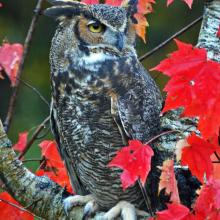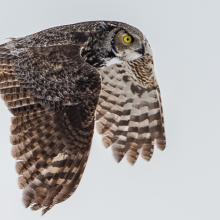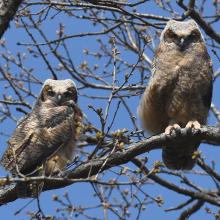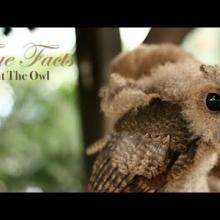

Join BirdNote tomorrow, November 30th!
Illustrator David Sibley and actor H. Jon Benjamin will face off in the bird illustration battle of the century during BirdNote's Year-end Celebration and Auction!
I’m Emily, a fourth-grader at School in the Woods in Colorado Springs, Colorado. I love the Great Horned Owl’s call. Did you know that Great Horned Owls almost always hunt at night? First, they locate their prey from small movements on the ground. Next, they dive down at the perfect moment. Finally, they catch their prey with huge talons on their feet.
BirdNote thanks the families and teachers who inspire young people to love birds and natural science.
BirdNote®
Emily Hears Great Horned Owls Call
Written by Emily Clark
This is BirdNote! Today we have a special guest.
[Great Horned Owl adult squawk – crickets in background]
“What was that? [Repeat screech] It must have been a Great Horned Owl!
Did you know that Great Horned Owls almost always hunt at night? I’m Emily, a fourth grader at School in the Woods. I love the Great Horned Owl’s call.
[Hoots of Great Horned Owl adult]
Great Horned Owls hunt from their excellent ears. The first way they hunt is they locate their prey from small movements on the ground. Next, they dive down at just the perfect moment. Finally, they catch the prey with huge talons on their feet.
Young Great Horned Owls are fed voles and rabbits until they are about 4 1/2 months old. After that, they have to fend for themselves.
[Screech of juvenile Great Horned Owl]
BirdNote writer Frances Wood says: “As nestlings, some shuffle out to the nearest branch, while others take the “Big Leap.” The young owls practice flying by taking short, cautious flights to nearby branches on neighboring trees before they depart the nesting area.” (1)
[Sounds of the young owl and parents]
Young owls’ first hunting forays are clumsy. They catch no more than large insects, and sometimes sick or young mammals.
[Great Horned Owl hoot] Hey, there’s that Great Horned Owl again! But this time, I’m hearing hooting instead of screeching.”
BirdNote thanks families and teachers who inspire in young people a love of birds and natural science. School in the Woods is in Colorado. Find a link to it at birdnote.org.
###
Bird sounds provided by The Macaulay Library of Natural Sounds at the Cornell Lab of Ornithology, Ithaca, New York. Squawk of adult Great Horned Owl [94364] recorded by W.L. Hershberger; crickets by N. Tucker; hoot of female Great Horned Owl and hoots of male and female [22874] by W.R. Fish; screech of juvenile [47685] D.S. Herr.
BirdNote’s theme music was composed and played by Nancy Rumbel and John Kessler.
Producer: John Kessler
Executive Producer: Chris Peterson
© 2013 Tune In to Nature.org July 2013 Narrator: Mary McCann
ID# GHOW-12-2013-07-23 GHOW-12 Special thanks to Carol and John Stansfield
If you're a teacher using BirdNote in the classroom, please let us know!








